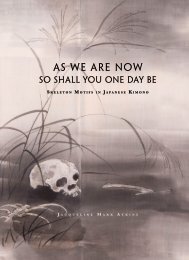You also want an ePaper? Increase the reach of your titles
YUMPU automatically turns print PDFs into web optimized ePapers that Google loves.
subdivided into multiple symmetrical columns of varying<br />
width and number. Patterned bands alternate with areas of<br />
solid color, usually gold or red. (A small number of tunics<br />
replace this standardized layout with atypical configurations,<br />
all-over patterning or even large-scale figuration.)<br />
The primary motif—whe<strong>the</strong>r a staff-bearing character or<br />
o<strong>the</strong>r supernatural or a profile or frontal face, or an abstract<br />
element like a spiral or fret—is repeated within all <strong>the</strong> vertical<br />
bands. And it is <strong>the</strong> dynamic, malleable treatment of this figure<br />
that is so visually arresting. The figure is typically subjected to<br />
a series of artistic conventions that result in its compression,<br />
expansion, inversion or reversal. The process ultimately leads to<br />
<strong>the</strong> total distortion of its modular parts and overall form.<br />
Each motif is composed using a stock vocabulary of rectilinear<br />
and curvilinear figurative or schematic elements. This<br />
constructivist approach to creating a figure out of geometric<br />
blocks—which are modified in shape, in scale and by color,<br />
according to an internal pattern scheme—yields mosaic-like<br />
designs. The compositions range markedly in <strong>the</strong>ir degree of<br />
visual cohesion and legibility—even to <strong>the</strong> point of visual<br />
fracture, when <strong>the</strong> geometricization and distortion are pushed<br />
to an extreme.<br />
The orientation of <strong>the</strong> motifs in <strong>the</strong> patterned bands also<br />
follows an internal logic established by <strong>the</strong> weaver or weaving<br />
workshop. The repeat figures are juxtaposed, inverted, doubled<br />
or paired in ingenious ways. Depending on whe<strong>the</strong>r <strong>the</strong>y are<br />
read on <strong>the</strong> vertical axis, as horizontal rows or in diagonal<br />
arrangements, some figures are shown twisting in opposite<br />
directions, for example, while o<strong>the</strong>rs may face <strong>the</strong> same way, or<br />
mirror each o<strong>the</strong>r across <strong>the</strong> center seam.<br />
This pattern of alternation is fur<strong>the</strong>r complicated by <strong>the</strong><br />
rhythmic magnification and condensation of <strong>the</strong> smaller<br />
components or details of <strong>the</strong> design (such as a wing, staff,<br />
head or headdress). These shifts visibly alter <strong>the</strong> proportions,<br />
delineation and clarity of <strong>the</strong> overall image.<br />
If this process were not sufficiently confounding, it also<br />
intersects with a sophisticated use of color, which is applied in<br />
predictable combinations that recur in a fixed number, order<br />
and direction across <strong>the</strong> entire compositional field of <strong>the</strong> tunic.<br />
Even though <strong>the</strong>se color clusters, or blocks of associated colors,<br />
are repeated at regular intervals, <strong>the</strong>y are aligned and staggered<br />
on parallel diagonal lines that may converge, cross or move<br />
up and down in opposite directions. This progression can be<br />
mapped graphically, as Susan Bergh has done. But because <strong>the</strong><br />
faceted surface and prismatic color usually mask <strong>the</strong> underlying<br />
order, it not easily distinguishable by <strong>the</strong> viewer. Moreover,<br />
randomly placed and arbitrary color substitutions, or deviations<br />
in <strong>the</strong> hue of any one element, large or small (an aes<strong>the</strong>tic<br />
predilection common to Andean weavers <strong>from</strong> all cultures and<br />
periods), may fur<strong>the</strong>r disrupt <strong>the</strong> sequence, thus baffling most<br />
readings. (This type of analysis is particularly difficult to grasp<br />
when <strong>the</strong> textile is incomplete or fragmentary.)<br />
Why most Wari tunic iconography focuses almost exclusively<br />
on <strong>the</strong> attendant staff-bearer, ra<strong>the</strong>r than <strong>the</strong> primary waka<br />
or Cosmic/Creator Deity, is unanswerable. It may have to<br />
do with <strong>the</strong> political and military nature of <strong>the</strong> Wari state.<br />
Perhaps this imperial society took on <strong>the</strong> role of proselytizer<br />
of <strong>the</strong> Tiwanaku (or highland) religious vision. Or, possibly,<br />
its officials saw <strong>the</strong>mselves as members of a “divine legion"<br />
who paid veneration to <strong>the</strong> Cosmic Deity and sought to direct<br />
<strong>the</strong> resources of <strong>the</strong> larger Andean realm toward it (while<br />
benefitting <strong>from</strong> <strong>the</strong> power and control over such resources).<br />
The result of this cultural imperative was a powerful artistic<br />
vision that encoded its message of shamanistic transcendence<br />
in a collectively created visual and symbolic language that left<br />
room for individual genius.<br />
1 Susan E. Bergh, “Tapestry Woven Tunics," in Wari. Lords of <strong>the</strong> <strong>Ancient</strong> <strong>Andes</strong>, ed.<br />
Susan E. Bergh (2012): 166.<br />
2 Anita Cook, “The Coming of <strong>the</strong> Staff Deity," in ibid., 112-113.<br />
TheWinged, Avian Staff-Bearer on <strong>the</strong> Gateway of <strong>the</strong> Sun at Tiwanaku.<br />
Adapted <strong>from</strong> Anton 1984, 107.<br />
38



